Web Infantry Equipment, Pattern 1913 - Equipment Carriers
The Canadian Web Equipment, Pattern 1913, was introduced with Canadian List of Changes entry No. 1203 (not dated but 1913).
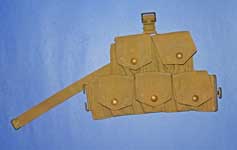
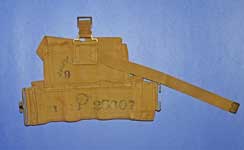 The Web Infantry Equipment, Pattern 1913, Ammunition carrier is unique among Mills designs. It is a symmetrical "two over three" Carrier, with a 1-inch vertical buckled strap centrally placed between the two upper pockets. It has a Patt. '08 style 45° diagonal strap extending rearwards from the upper row of cartridge pockets. It is also a Back Adjustment design, and connects to the Adjustment strap using a 2-inch double hook at the rear. In the rear view, notice the connection between the Carrier proper and the upper buckle. It is similar, but not identical to, the connection later used on W.E. Patt's. '19 and '25. This right Carrier is the only surviving example KW have seen. It is maker marked "M.E. Co." and dated 1913. From the Ed Storey Collection.
The Web Infantry Equipment, Pattern 1913, Ammunition carrier is unique among Mills designs. It is a symmetrical "two over three" Carrier, with a 1-inch vertical buckled strap centrally placed between the two upper pockets. It has a Patt. '08 style 45° diagonal strap extending rearwards from the upper row of cartridge pockets. It is also a Back Adjustment design, and connects to the Adjustment strap using a 2-inch double hook at the rear. In the rear view, notice the connection between the Carrier proper and the upper buckle. It is similar, but not identical to, the connection later used on W.E. Patt's. '19 and '25. This right Carrier is the only surviving example KW have seen. It is maker marked "M.E. Co." and dated 1913. From the Ed Storey Collection.
Ed has done some interesting research on this Carrier, and has added this history:
Along with the Canadian ‘C Broad Arrow’, this Cartridge Carrier has both the hand-written and presumably later stencilled Canadian Militia Service Number of 28607. Canadian Library and Archive records reveal that this Cartridge Carrier was issued to John Clement Cowen whom, upon enlistment in the 16th Battalion CEF on 23 September, 1914, was a 32 years 8 month old fitter. Like the majority of the CEF, he had been born in the UK, in this case Tunbridge Wells, Kent. Of interest is that this bachelor had 12 years prior service in the Royal Engineers before volunteering to serve the Crown once again, this time for the Canadians. John Cowen survived his military service, even though his Battalion saw some of the toughest fighting of the Great War.
The 16th Canadian Infantry Battalion was organized at Valcartier under Camp Order 241 of 2 September 1914 and was composed of recruits from Victoria, Vancouver, Winnipeg and Hamilton. The battalion was commanded by Lieutenant-Colonel R.G.E. Leckie.
The battalion embarked at Quebec on 30 September 1914 aboard ANDANIA, disembarking in England on 14 October 1914. Its strength was 47 officers, 1111 other ranks. The battalion arrived in France on 7 February 1915, becoming part of the 3rd Infantry Brigade, 1st Canadian Division,. It was later reinforced by the 14th Canadian Reserve Battalion, and later by the 11th Canadian Reserve Battalion. The battalion returned to England on 27 March 1919, disembarked in Canada on 4 May 1919, was demobilized on 8 May 1919, and disbanded by General Order 149 of 15 September 1920.
The battalion mascot was a goat. The battalion published "The Brazier" between 15 Feb 1916 and 1 April 1917 (see RG 9III, Vol. 5077) and also published the "Canadian Scottish". The battalion supported a pipe band and had a concert party in France (see the War Diary of the 1st Labour Battalion, 25 Jan 1918). Its air was "Blue bonnets over the border". The battalion colours were transferred to the 72nd Seaforth Highlanders on 17 July 1919.
The 16th Canadian Infantry Battalion was perpetuated by The Canadian Scottish Regiment.
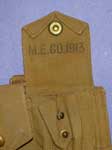
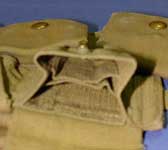
 Details of the right Ammunition carrier shown above. Like the Patt. '08 Cartridge carrier, each pocket holds three 5 round chargers.
Details of the right Ammunition carrier shown above. Like the Patt. '08 Cartridge carrier, each pocket holds three 5 round chargers.
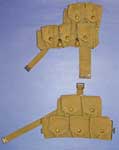 Another interesting photograph, this one showing a right Patt. '08 Cartridge carrier (above) and the right Patt. '13 Ammunition carrier below. All photos in this section © Ed Storey 2008.
Another interesting photograph, this one showing a right Patt. '08 Cartridge carrier (above) and the right Patt. '13 Ammunition carrier below. All photos in this section © Ed Storey 2008.

 At this point it seems reasonably certain that no Frog was actually issued with W.E. Patt. '13, in spite of the fact that these photographs, taken from the M.E. Co. Fitting Instructions, show one. The Ross bayonet scabbard had an integral belt loop. In the Canadian List of Changes entry for the earlier Canadian W.E. Patt. '08, No. 447, dated 1st September 1910, this issue is addressed. No web Frog was supplied with the Canadian Patt. '08. Instead, the C.L. of C. reads '"2. Scabbards, bayonet, Ross rifle, pattern '08 with lengthened loop" ...to complete Web Equipment on charge will be supplied...' With the later Patt. '13, the standard Ross scabbard fits just fine (we know, we tried one with a 2-inch Patt. '19 Back adjustment strap to make sure). C.L. of C. entry No. 1203 lists all of the components of W.E. Patt. '13, and does not mention a Frog. A Frog, identical to the one used for the concurrently produced Web Equipment, New Zealand Pattern 1913 (see below), was developed by M.E. Co. as part of the pattern, but it was not necessary in Canada and the Canadian order did not include this item. The Bayonet frog was included in the Mills Company instructions, of course, since the pattern was intended to be a world-wide replacement for Pattern 1908. South Africa, for example, did include the Frog in their Patt. '13 equipment, as shown in surviving documentation and photographs.
At this point it seems reasonably certain that no Frog was actually issued with W.E. Patt. '13, in spite of the fact that these photographs, taken from the M.E. Co. Fitting Instructions, show one. The Ross bayonet scabbard had an integral belt loop. In the Canadian List of Changes entry for the earlier Canadian W.E. Patt. '08, No. 447, dated 1st September 1910, this issue is addressed. No web Frog was supplied with the Canadian Patt. '08. Instead, the C.L. of C. reads '"2. Scabbards, bayonet, Ross rifle, pattern '08 with lengthened loop" ...to complete Web Equipment on charge will be supplied...' With the later Patt. '13, the standard Ross scabbard fits just fine (we know, we tried one with a 2-inch Patt. '19 Back adjustment strap to make sure). C.L. of C. entry No. 1203 lists all of the components of W.E. Patt. '13, and does not mention a Frog. A Frog, identical to the one used for the concurrently produced Web Equipment, New Zealand Pattern 1913 (see below), was developed by M.E. Co. as part of the pattern, but it was not necessary in Canada and the Canadian order did not include this item. The Bayonet frog was included in the Mills Company instructions, of course, since the pattern was intended to be a world-wide replacement for Pattern 1908. South Africa, for example, did include the Frog in their Patt. '13 equipment, as shown in surviving documentation and photographs.

 The Frog for the Mills Web Modified Pattern Equipment, also called the Web Equipment, New Zealand Pattern 1913. This Frog is designed to accept the scabbard for the Pattern 1888 or Pattern 1907 Bayonet. Its similarity to the Frog shown in the pictures above, and to the later Patt's. '19, '25, and '37 Frogs, is obvious. You can put a Ross bayonet in scabbard in this Frog, but unless you damage the scabbard by removing the integral belt loop, there seems little reason to do so. This example is maker marked "M.E. Co." and dated 1913. From the Karkee Web Collection.
The Frog for the Mills Web Modified Pattern Equipment, also called the Web Equipment, New Zealand Pattern 1913. This Frog is designed to accept the scabbard for the Pattern 1888 or Pattern 1907 Bayonet. Its similarity to the Frog shown in the pictures above, and to the later Patt's. '19, '25, and '37 Frogs, is obvious. You can put a Ross bayonet in scabbard in this Frog, but unless you damage the scabbard by removing the integral belt loop, there seems little reason to do so. This example is maker marked "M.E. Co." and dated 1913. From the Karkee Web Collection.
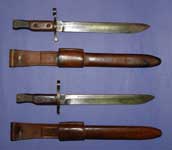 Here are pictures of the Ross M1905 (above) and M1910 (below) bayonets, each with a Mk. II scabbard. As can readily be seen, with the integral belt loops there is no need for Frogs. During WWII, some Ross bayonet scabbards had their belt loops removed, and Patt. 1907 style lockets and frog studs added, to enable them to be used with Patt. '08 Frogs. From the Ed Storey Collection. Photograph © 2008 Ed Storey.
Here are pictures of the Ross M1905 (above) and M1910 (below) bayonets, each with a Mk. II scabbard. As can readily be seen, with the integral belt loops there is no need for Frogs. During WWII, some Ross bayonet scabbards had their belt loops removed, and Patt. 1907 style lockets and frog studs added, to enable them to be used with Patt. '08 Frogs. From the Ed Storey Collection. Photograph © 2008 Ed Storey.
Carrier, waterbottle (combination for waterbottle and intrenching tool)


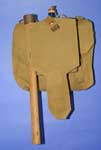 The Carrier, waterbottle (combination for waterbottle and intrenching tool), is a combination of two Carriers in one assembly. The Waterbottle carrier resembles the Patt. '08 second issue. Sewn to it is a combined Carrier for the Sirhind intrenching tool Head and Helve. The photo near right shows the Carrier mounted on the Haversack. It was normally carried below the waist on the right side, suspended from the Brace ends. This example is maker marked "M.E. Co." and dated 1913. From the Ed Storey Collection. Photograph © 2008 Ed Storey.
The Carrier, waterbottle (combination for waterbottle and intrenching tool), is a combination of two Carriers in one assembly. The Waterbottle carrier resembles the Patt. '08 second issue. Sewn to it is a combined Carrier for the Sirhind intrenching tool Head and Helve. The photo near right shows the Carrier mounted on the Haversack. It was normally carried below the waist on the right side, suspended from the Brace ends. This example is maker marked "M.E. Co." and dated 1913. From the Ed Storey Collection. Photograph © 2008 Ed Storey.
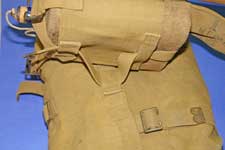
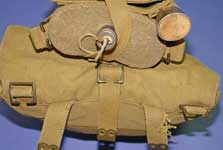 These two photos show the procedure for fitting the Carrier, waterbottle, to the Haversack. Compare with the same procedure shown on the Pattern 1908 Haversacks page. Both work the same way, with very similar fittings.
These two photos show the procedure for fitting the Carrier, waterbottle, to the Haversack. Compare with the same procedure shown on the Pattern 1908 Haversacks page. Both work the same way, with very similar fittings.